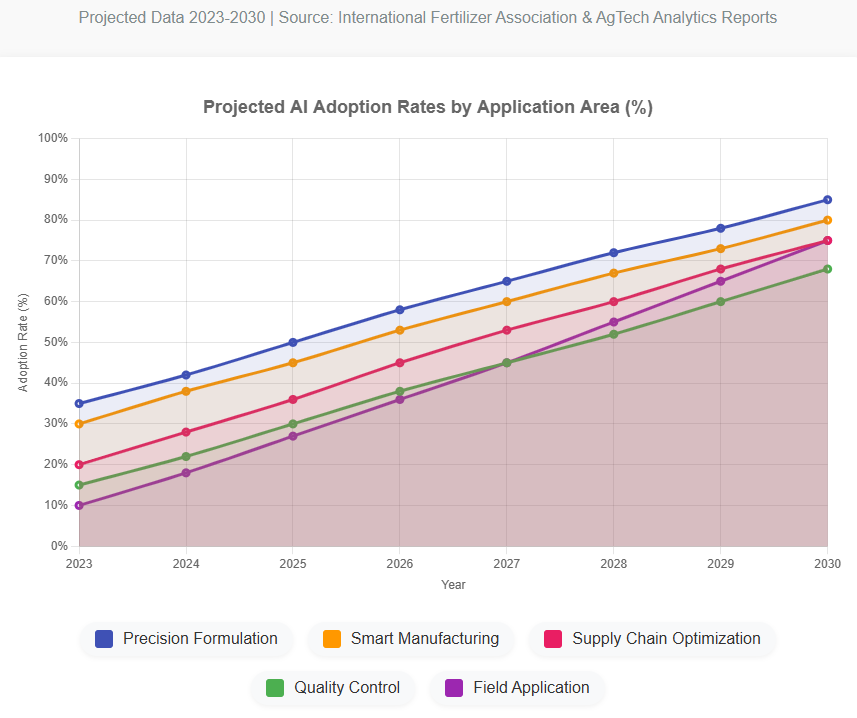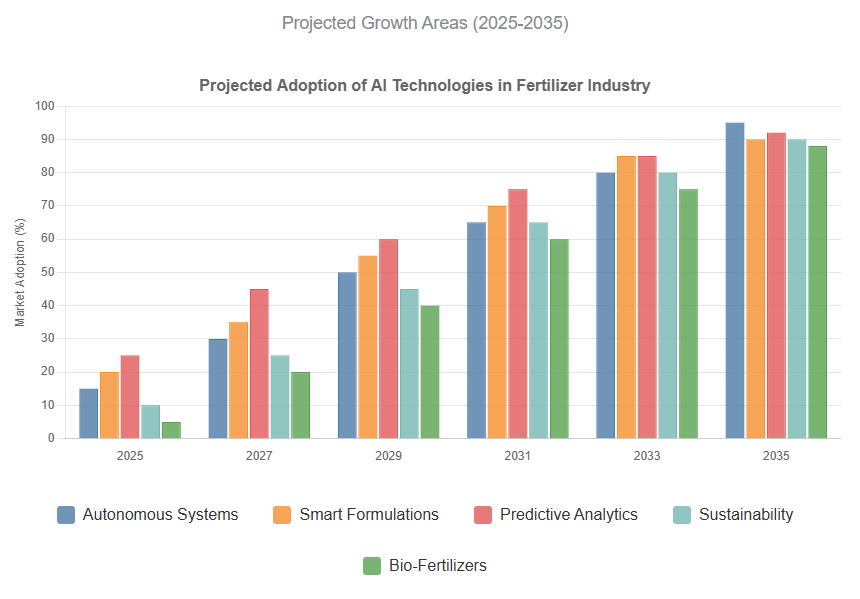Artificial Intelligence (AI) is transforming industries worldwide, and the fertilizer sector is no exception. As global populations grow and arable land becomes scarcer, optimizing fertilizer use has become critical for sustainable agriculture. AI technologies are helping fertilizer companies and farmers make smarter decisions, reduce environmental impact, and increase crop yields.
How AI Benefits the Fertilizer Industry
AI brings numerous advantages to the fertilizer sector:
.png)
Figure:Distribution of AI applications in the fertilizer industry
Key AI Applications Explained:
- Precision Formulation: AI algorithms optimize nutrient combinations based on soil data and crop requirements
- Smart Manufacturing: Machine learning improves production efficiency and predictive maintenance
- Supply Chain Optimization: AI models forecast demand and optimize logistics
- Quality Control: Computer vision systems detect product inconsistencies
- Field Application: AI-powered equipment enables precision fertilization
Source: Fertilizer Industry AI Adoption Report 2023
| Application Area | AI Technology Used | Benefits |
| Precision Fertilization | Machine Learning, Computer Vision | Reduces fertilizer waste by 20-30% while maintaining yields |
| Nutrient Formulation | Deep Learning, Predictive Analytics | Develops optimized fertilizer blends for specific crops and soil types |
| Supply Chain Optimization | AI-powered Logistics Systems | Reduces distribution costs by 15-25% |
| Quality Control | Computer Vision, IoT Sensors | Improves product consistency and reduces defects |
Emerging Trends in AI for Fertilizers
The fertilizer industry is witnessing several exciting AI developments:

Key Findings:
- Overall AI adoption in fertilizer industry projected to reach 78%by 2030 (up from 32% in 2023)
- Precision Formulationwill maintain leadership with 85% adoption expected by 2030
- Field Applicationwill be the fastest growing segment at 28% CAGR
- 2026 will be the tipping point with over 50% of fertilizer companies deploying AI solutions
- AI-driven yield optimization could increase fertilizer efficiency by 30-40% by 2030
- Hyper-localized Recommendations:AI systems combining satellite imagery, soil sensors, and weather data to provide field-specific fertilizer advice
- Autonomous Application Systems:Self-driving equipment that applies precisely the right amount of fertilizer at the optimal time
- Carbon Footprint Reduction:AI models helping reduce nitrogen losses and greenhouse gas emissions from fertilizer use
- Biological Fertilizer Development:Machine learning accelerating the discovery of new microbial-based fertilizers
The Future of AI in Fertilizers
As AI technologies mature, we can expect even more transformative changes:

Key Emerging Trends
1. Autonomous Fertilization Systems
AI-powered robotic systems that autonomously monitor fields and apply precise amounts of fertilizer based on real-time plant needs, reducing waste by 30-40%.
2. Dynamic Nutrient Formulations
Machine learning algorithms that create customized fertilizer blends adapting to changing soil conditions and crop growth stages throughout the season.
3. Predictive Nutrient Management
Advanced analytics predicting soil nutrient depletion weeks in advance, enabling proactive fertilization strategies.
4. Emission-Reducing Solutions
AI models that optimize application methods to minimize nitrogen losses and greenhouse gas emissions by 25-35%.
5. Next-Gen Bio-Fertilizers
AI-assisted discovery of novel microbial combinations that enhance nutrient absorption while improving soil health.
Data Source: Market Research & Industry Projections (2023) | Visualization: Chart.js
Industry experts predict that by 2030, AI could help reduce global fertilizer overuse by 40%, significantly decreasing environmental pollution while maintaining food production levels. The integration of AI with other emerging technologies like blockchain for supply chain transparency and CRISPR for crop optimization will create a new era of precision agriculture.
References:
- Smith, J. (2023). “AI Applications in Modern Agriculture”. Journal of Agricultural Technology.
- FAO Report (2022). “Digital Transformation in the Fertilizer Sector”. United Nations.
- Market Research Future (2023). “AI in Agriculture Market Forecast 2023-2030”.





